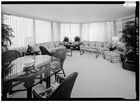"We will not be aggressors," said President Eisenhower, "but we ... have and will maintain a massive capability to strike back." Eisenhower's comments reflected the doctrinal basis behind much of America's strategic planning during the Cold War era. Learn more about how the Eisenhower administration moved beyond containment and addressed new Soviet threats.
-
Article 1: President Eisenhower "Wages Peace"

Shortly after the lifting of the Berlin Blockade, in August 1949, the Soviet Union broke the American nuclear monopoly by developing its own atomic bomb. This development forced the United States to reevaluate its defense posture and accelerated the creation of even more powerful weapons, such as the hydrogen bomb, to regain its nuclear superiority. As president, Eisenhower struggled to balance defense and spending. Read more
-
Article 2: “Project Solarium”

As Commander-in-Chief and as a former Army General, Eisenhower at least exerted greater control over the military. He called for a reconsideration of the country’s Cold War policies upon taking office and initiated “Project Solarium”—named for the room of the White House where the project was discussed—which requested three blue-ribbon, top secret panels to separately consider and propose a strategy for America’s Cold War policy. Read more
-
Article 3: The Problem of Massive Retaliation
Massive retaliation limited the Eisenhower administration’s policy options. The decision not to use nuclear weapons in Vietnam called into question the administration’s policy of massive retaliation and deterrence. Massive retaliation might have been a successful policy for keeping the Cold War in balance and an option for stopping a major Soviet advance into Western Europe–although it was never put to this test–but it did not answer everything. Read more
-
Minuteman Missile National Historic Site
Article 4: The Shock of Sputnik

On October 4, 1957, the Soviet Union successfully launched into orbit the world's first artificial satellite, Sputnik. Ham radio operators in the eastern United States turned their dials to lower frequency bands and anxiously listened as the 184-pound Sputnik emitted a mechanical " . . . beep . . . beep . . . beep . . . " while passing overhead. Read more
